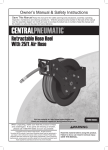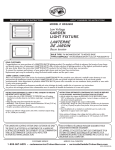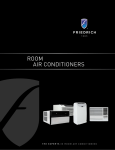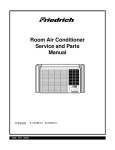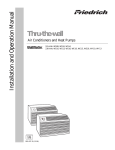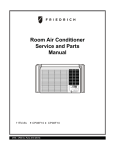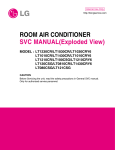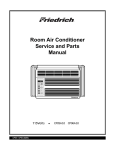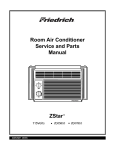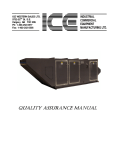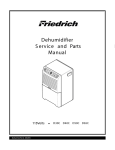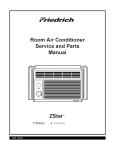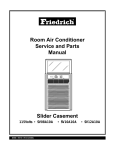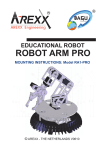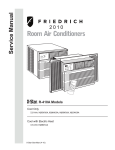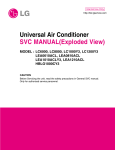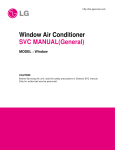Download CP10 & CP12 Chill Room Air Conditioner
Transcript
Room Air Conditioner Service & Parts Manual 2014-2015 CP10 & CP12 Chill 115 Volts THE EXPERTS IN ROOM AIR CONDITIONING 93011402_04 CONTENTS 1. PREFACE 2.4 REFRIGERATION CYCLE.................................9 2.4.1 CONDENSER ......................................9 2.4.2 EVAPORATOR ....................................9 2.4.3 CAPILLARY TUBE...............................9 1.1 SAFETY PRECAUTIONS ...............................2 1.2 INSULATION RESISTANCE TEST.................2 1.3 PRODUCT SPECIFICATIONS .......................3 1.4 OPERATING INSTRUCTIONS.......................4 3. SCHEMATIC DIAGRAM 3.1 CIRCUIT DIAGRAM ......................................12 2. DISASSEMBLY INSTRUCTIONS 4. TROUBLESHOOTING GUIDE 2.1 MECHANICAL PARTS....................................5 2.1.1 FRONT GRILLE .....................................5 2.1.2 CABINET................................................5 2.1.3 CONTROL BOX .....................................5 2.2 AIR HANDLING PARTS..................................6 4.1 PIPING SYSTEM ..........................................13 4.2 TROUBLESHOOTING GUIDE......................14 5. EXPLODED VIEW ..................................19 6. SERVICEPARTS LIST 2.2.1 COVER (AT THE TOP)..........................6 2.2.2 AIR GUIDE AND BLOWER....................6 ......................21 2.2.2 FAN A N D S H R O U D ..........................6 2.2.3 MOTOR ................................................7 2.3 ELECTRICAL PARTS .....................................7 2.3.1 OVER LOAD PROTECTOR...................7 2.3.2 COMPRESSOR .....................................7 2.3.3 CAPACITOR ..........................................8 2.3.4 POWER CORD ......................................8 1. PREFACE This SERVICE MANUAL provides various service information, including the mechanical and electrical parts etc. This room air conditioner was manufactured and assembled under a strict quality control system. The refrigerant is charged at the factory. Be sure to read the safety precautions prior to servicing the unit. 1.1 SAFETY PRECAUTIONS 1. When servicing the unit, turn off the air conditioner and unplug the power cord. 2. Observe the original lead dress. If a short circuit is found, replace all parts which have been overheated or damaged by the short circuit. 3. After servicing the unit, make an insulation resistance test to protect the customer from being exposed to shock hazards. 1.2 INSULATION RESISTANCE TEST 1. Unplug the power cord and connect a jumper between 2 pins (black and white). 2. The grounding conductor (green or green & yellow) is to be open. 3. Measure the resistance value with an ohm meter between the jumpered lead and each exposed metallic part on the equipment. 4. The value should be over 1M . —2— 1.3 PRODUCT SPECIFICATIONS Buyer Model PERFORMANCE BTU performance (Cooling) BTU performance (Heating) EER COP Dehumid. ( Pts/Hr) Dry Air Flow (CFM) dBA Level (Indoor / Outdoor) Est. Cooling Area (SQ.FT) Electrical Ratings Voltage / 60 Hz Watts (Cooling) Watts (Heating) Rated Amps (Cooling) Rated Amps (Heating) Features Thermostat Control Air Diflection Remote controller Auto swing Auto Restart Energy saver fuction Timer Sleep Filter Alarm Function Fan Speed: Cooling(Heating) Fan Only Compressor In Door Fan Type Type Air Discharge Outdoor Vent / Exhaust Rear grille Chassis Type Others Carton Height(inch) Width Depth Demension Height(inch) Width Depth Net Weight(lbs.) Shippling Weight(lbs.) Stuffing Quantity (20/4040Hi ft) CP10G10A CP12G10A 10,000 12000 11.3 11.3 3 300 53/58 450 3.3 330 53/58 550 115 880 115 1060 8.5 9.7 Thermistor 4-Way Yes Yes Yes Yes 24Hr,On/Off Yes 3 3 ROTARY TURBO Side Yes Yes Slide In-Out Thermistor 4-Way Yes Yes Yes Yes 24Hr,On/Off Yes 3 3 ROTARY TURBO Side Yes Yes Slide In-Out 18 1/8 27 1/16 23 5/8 14 31/32 23 5/8 22 1/16 77 88 135/297/297 18 1/8 27 1/16 23 5/8 14 31/32 23 5/8 22 1/16 84 95 135/297/297 —3— 1.4 OPERATING INSTRUCTIONS 6 8 7 7 6 3 5 2 5 4 3 2 1 MoneySaver: The fan will stop when the compressor stops cooling. The fan will turn on approximately every 3 minutes to sample to room air and determine if more cooling is needed. Cool: fan runs continually for normal cooling operation Fan Only: Fan-only operation *MoneySaver has it’s own button on your remote control 4. CHECK FILTER & FILTER RESET Check Filter: Your ‘Check Filter’ LED will light up after approximately 250 hours of operation, notifying you that your filter needs to be cleaned. Filter Reset: press ‘Temp ∨∧’ together to turn off ‘Check Filter’ light. *Filter Reset must be done from unit control panel, not remote control *Timer Clear: On remote control, ‘Timer Clear’ button will cancel the timer setting 8 6. OPERATION MODE SELECTOR Push the ‘Mode’ button to rotate between MoneySaver → Cool → Fan → Dry modes. (select Dry mode for dry/dehumidifier operation) —4— 2. DISASSEMBLY INSTRUCTIONS — Before the following disassembly, POWER SWITCH is set to OFF and disconnected the power cord. 2.1 MECHANICAL STRUCTURE 2.1.1 FRONT GRILLE 1. Open the lnlet grille upward or downward. 2. Remove the screw which fastens the front grille. 3. Pull the front grille from the right side. 4. Remove the front grille. 5. Re-install the component by referring to the removal procedure, above.(See Figure 17) Figure 17 2.1.2 CABINET 1. After disassembling the FRONT GRILLE, remove the 2 screws which fasten the cabinet at both sides. 2. Remove the 2 screws which fasten the cabinet at back. 3. Pull the base pan forward. (See Figure 18) 4. Remove the cabinet. 5. Re-install the component by referring to the removal procedure, above. Figure 18 2.1.3 CONTROL BOX 1. Disconnect the unit from the power source. 2. Remove the front grille. 3. Remove the cabinet. 4. Remove the screw which fastens the control box cover. 5. Remove the housing which connects motor wire in the control box. 6. Remove the 3 leads from the compressor. 7.Discharge the capacitor by placing a 20,000 ohmresistor across the capacitor terminals. 8. Remove the 2 screws which fasten the control box.(See Figure 19) 9. Pull the control box forward completely. 10. Re-install the components by referring to the removal procedure, above. (See Figure 19) Figure 19 —5— Air handling parts 2.2 AIR HANDLING PARTS 2.2.1. AIR GUIDE AND BL OWER 1. Remove the front grille. 2. Remove the cabinet. 3. Remove the control box. 4. Remove the 3 screws which fasten the brace. 5. Remove the brace. 6. Remove the 2 screws which fasten the evaporator. 7. Move the evaporator forward and pulling it upward slightly. (See Figure 20) 8. Move the evaporator to the left carefully. 9. Pull out the hook of orifice by pushing the tabs and remove it. (See Figure 21) 10. Remove the clamp with a hand plier which secures the blower. 11. Remove the blower. 12. Remove the 4 screws which fasten the air guide from the barrier. 13. Move the air guide backward, pulling out from the base pan. 14. Re-install the components by referring to the removal procedure, above. Figure 20 Figure 21 2.2.2 FAN AND SHROUD 1. Remove the cabinet. 2. Remove the brace. 3. Remove the 3 screws which fasten the condenser. 4. Move the condenser to the left carefully. 5. Remove the clamp which secures the fan. 6. Remove the fan and then pull out the shroud. (See Figure 22) 7. Re-install by referring to the removal procedure. Figure 22 —6— 2.2.3. MOTOR 1. Remove the cabinet. 2. Remove the evaporator. 3. Remove the orifice. 4. Remove the blower. 5. Remove the fan. 6. Remove the control box cover and housing of the motor in the control box. 7. Remove the 2 screws which fasten the motor from the mount motor. (See Figure 23) 8. Remove the motor. 9. Re-install the components by referring to the removal procedure, above.(See Figure 23) Figure 23 2.3 ELECTRICAL PARTS 2.3.1. OVERLOAD PROTECTOR 1. Remove the cabinet. 2. Remove the nut which fastens the terminal cover. 3. Remove the terminal cover. (See Figure 24) 4. Remove all the leads from the overload protector. 5. Remove the overload protector. 6. Re-install the component by referring to the removal procedure, above. Figure 24 2.3.2. COMPRESSOR 1. Remove the cabinet. 2. Discharge the refrigerant system using a FreonTM Recovery System. If there is no valve to attach the recovery system, install one (such as a WATCO A-1) before venting the FreonTM. Leave the valve in place after servicing the system. 3. Remove the overload protector. 4. After purging the unit completely, unbraze the suction and discharge tubes at the compressor connections. 5. Remove the 3 nuts and the 3 washers which fasten the compressor. 6. Remove the compressor. (See Figure 25) 7. Re-install the components by referring to the removal procedure, above. Figure 25 —7— 2.3.3. CAPACITOR 1. Remove the control box. 2. Remove the screw which fasten control panel from control box. 3. Remove the screw which located in the front. 4. Open the bottom side of control box. 5. Remove the screw and the clamp which fastens the capacitor. 6. Disconnect all the leads of capacitor terminals. 7. Re-install the components by referring to the removal procedure, above. (See Figure 27) Figure 27 2.3.4. POWER CORD 1. Remove the control box. 2. Open the control box. 3. Disconnect the grounding screw from the control box. 4. Disconnect the 2 receptacles. 5. Remove a screw which fastens the clip cord. (See Figure 30) 6. Remove the power cord. 7. Re-install the component by referring to the above removal procedure, above. (Use only one ground-marked hole for ground connection.) 8. If the supply cord of this appliance is damaged, it must be replaced by the special cord. (The special cord means the cord which has the same specification marked on the supply cord attached at the unit.) —8— Figure 30 2.4 REFRIGERATION CYCLE CAUTION: Discharge the refrigerant system using Freon TM Recovery System.If there is no valve to attach the recovery system, install one (such as a WATCO A-1) before venting the Freon TM. Leave the valve in place after servicing the system. 2.4.1 CONDENSER 1. Remove the cabinet. 2. Remove the 3 screws which fasten the brace. 3. Remove the 3 screws which fasten the condenser and shroud. 4. After discharging the refrigerant completely, unbraze the interconnecting tube at the condenser connections. 5. Remove the condenser carefully. 6. Re-install the component by referring to notes. (See Figure 31) Figure 31 2.4.2 EVAPORATOR 1. Remove the cabinet. 2. Remove the 2 screws which fasten the evaporator. 3. Move the evaporator sideways carefully. 4. After discharging the refrigerant completely, unbraze the interconnecting tube at the evaporator connections. 5. Remove the evaporator carefully. 6. Re-install the component by referring to notes. (See Figure 32) 2.4.3 CAPILLARY TUBE 1. Remove the cabinet. 2. After discharging the refrigerant completely, unbraze the interconnecting tube at the capillary tube. 3. Remove the capillary tube. 4. Re-install the component by referring to notes. —9— Figure 32 NOTICE -Replacement of the refrigeration circuit. 1. When replacing the refrigeration circuit, be sure to Discharge the refrigerant system using a FreonTM recovery System. If there is no valve to attach the recovery system, install one (such as a WATCO A-1) before venting the FreonTM. Leave the valve in place after servicing the system. 2. After discharging the unit completely, remove the desired component, and unbraze the pinch-off tubes. 3. Solder service valves into the pinch-off tube ports, leaving the valves open. 4. Solder the pinch-off tubes with Service valves. 5. Evacuate as follows. 1) Connect the vacuum pump, as illustrated figure 33A. 2) Start the vacuum pump, slowly open manifold valves A and B with two full turns counterclockwise and leave the valves open. The vacuum pump is now pulling through valves A and B up to valve C by means of the manifold and entire system. CAUTION: If high vacuum equipment is used, just crack valves A and B for a few minutes, then open slowly with the two full turns counterclockwise. This will keep oil from foaming and being drawn into the vacuum pump. 3) Operate the vacuum pump vaccum for 20 to 30 minutes, until 600 microns of vaccum is obtained. Close valves A and B, and observe vacuum gauge for a few minutes. A rise in pressure would indicate a possible leak or moisture remaining in the system. With valves A and B closed, stop the vacuum pump. 4) Remove the hose from the vacuum pump and place it on the charging cylinder. See figure 37B. Open valve C. Discharge the line at the manifold connection. 5) The system is now ready for final charging. 6. Recharge as follows : 1) Refrigeration cycle systems are charged from the High-side. If the total charge cannot be put in the High-side, the balance will be put in the suction line through the access valve which you installed as the system was opened. 2) Connect the charging cylinder as shown in figure 33B. With valve C open, discharge the hose at the manifold connection. 3) Open valve A and allow the proper charge to enter the system. Valve B is still closed. 4) If more charge is required, the high-side will not take it. Close valve A. 5) With the unit running, open valve B and add the balance of the charge. a. Do not add the liquid refrigerant to the Low-side. b. Watch the Low-side gauge; allow pressure to rise to 30 lbs. c. Turn off valve B and allow pressure to drop. d. Repeat steps b. and c. until the balance of the charge is in the system. 6) When satisfied the unit is operating correctly, use the pinch-off tool with the unit still running and clamp on to the pinch-off tube. Using a tube cutter, cut the pinch-off tube about 2 inches from the pinch-off tool. Use sil-fos braze and braze pinch-off tube closed. Turn off the unit, allow it to set for a while, and then test the leakage of the pinch-off connection. —10— Equipment needed: Vacuum pump, Charging cylinder, Manifold gauge, Brazing equipment. Pin-off tool capable of making a vapor-proof seal, Leak detector, Tubing cutter, Hand Tools to remove components, Service valve. COMPOUND GAUGE CONDENSER (HIGH PRESSURE SIDE) MANIFOLD GAUGE A B CAPILLARY TUBE SEE INSETS BELOW EVAPORATOR (LOW PRESSURE SIDE) COMPRESSOR LOW HI A B B EXTERNAL VACUUM PUMP A CHARGING CYLINDER C Figure 33B-Charging Figure 33A-Pulling Vacuum —11— 3. SCHEMATIC DIAGRAM CN-N3 3.1 CIRCUIT DIAGRAM BR CN-PRESS BR Pressure Switch BK BK (SMPS) 250V/T3.15A PN:MEZ65238803 Fault Codes Error No. Error Item Error Content CH01 Indoor Air Sensor Error Indoor air sensor open or short CH09 EEPROM CheckSum Error EEPROM reading date error CH34 High Pressure Error As high pressure,comp off over 10 times in 1 hour. —12— 4. TROUBLESHOOTING GUIDE 4.1 PIPING SYSTEM CONDENSER COIL FAN CAPILLARY TUBE MOTOR COMPRESSOR BLOWER EVAPORATOR COIL Figure 32 is a brief description of the important components and their function in what is called the refrigeration system. This will help you to understand the refrigeration cycle and the flow of the refrigerant in the cooling cycle. ROOM AIR CONITIONER CYCLE OF REFRIGERATION EVAPORATOR COILS CONDENSER COILS COMPLETE LIQUID BOIL OFF POINT COOLED AIR SUCTION LINE COOL LOW PRESSURE VAPOR VAPOR INLET HOT DISCHARGED AIR ROOM AIR HEAT LOAD MOTOR OUTSIDE COOLING AIR FOR REFRIGERANT PASS THROUGH COMPRESSOR OIL LIQUID PRESSURE DROP LIQUID OUTLET (LIQUID REFRIGERANT) CAPILLARY TUBE HIGH PRESSURE VAPOR LIQUID REFRIGERANT LOW PRESSURE VAPOR Figure 32 —— 4.2 TROUBLESHOOTING GUIDE In general, possible trouble is classified in two causes. The one is called Starting Failure which is caused from an electrical defect, and the other is Ineffective Air Conditioning caused by a defect in the refrigeration circuit and improper application. Unit is running but cooling is ineffective Ineffective Cooling Check of cold air circulation for smooth flow. Check of outdoor coil (heat exchanger) & the fan operation. Dirty indoor coil (Heat exchanger) Check gas leakage. Malfunction of fan Repair gas leak. Clogged of air filter Replacement of unit if the unit is beyond repair. Check heat load increase. Unexpected residue Overloaded Circuit Obstruction at air outlet Check of inside gas pressure. Adjusting of refrigerant charge Stop of auto air-swing Malfunction of compressor Correct above trouble Replacement of compressor Check clogging in refrigeration circuit. Repair clogging in refrigeration circuit. Satisfactory operation with temperature difference of inlet & outlet air ; 44.6~50 F —14— Fails to Start Check of power source. Check of circuit breaker and fuse. Check of control switch setting. Gas leakage of feeler bulb of thermostat Check of control switch. Only compressor fails to start. Only fan fails to start. Improper wiring. Drop of power voltage. Improper thermostat setting Defect of compressor capacitor. Loose terminal connection. Check capacitor. Improper wiring Defect of fan motor capacitor. Irregular motor resistance ( ). Irregular motor insulation ( ). Replacement. Replacement of fan motor Irregular motor resistance ( ) Regular but fails to start Irregular motor insulation ( ) Replacement of compressor (locking of rotor, metal) Replacement of compressor (Motor damaged) —15— COMPLAINT Fan motor will not run. CAUSE REMEDY No power Check voltage at outlet. Correct if none. Power supply cord Check voltage to rotary switch. If none, check power supply cord. Replace cord if circuit is open. Rotary switch Check switch continuity. Refer to wiring diagram for terminal identification. Replace switch if defective. Wire disconnected or connection loose Connect wire. Refer to wiring diagram for terminal identification. Repair or replace loose terminal. Capacitor (Discharge capacitor before testing.) Test capacitor. Replace if not within ±10% of manufacturer's rating. Replace if shorted, open, or damaged. Will not rotate Fan blade hitting shroud or blower wheel hitting scroll. Realign assembly. Units using slinger ring condenser fans must have 1/4 to 5/16 inch clearance to the base. If it is hitting the base, shim up the bottom of the fan motor with mounting screw(s). Check fan motor bearings; if motor shaft will not rotate, replace the motor. Fan motor runs intermittently Revolves on overload. Check voltage. See limits on this page. If not within limits, call an electrician. Test capacitor. Check bearings. Does the fan blade rotate freely? If not, replace fan motor. Pay attention to any change from high speed to low speed. If the speed does not change, replace the motor. Fan motor noise. Grommets Check grommets; if worn or missing, replace them. Fan If cracked, out of balance, or partially missing, replace it. Turbo fan If cracked, out of balance, or partially missing, replace it. Loose set screw Tighten it. Worn bearings If knocking sounds continue when running or loose, replace the motor. If the motor hums or noise appears to be internal while running, replace motor. —16— COMPLAINT Compressor will not run, but fan motor runs. CAUSE REMEDY Voltage Check voltage. See the limits on the preceding. page. If not within limits, call an electrician. Wiring Check the wire connections, if loose, repair or replace the terminal. If wires are off, refer to wiring diagram for identification, and replace. Check wire locations. If not per wiring diagram, correct. Rotary Check for continuity, refer to the wiring diagram for terminal identification. Replace the switch if circuit is open. Thermostat Check the position of knob If not at the coldest setting, advance the knob to this setting and restart unit. Check continuity of the thermostat. Replace thermostat if circuit is open. Capacitor (Discharge capacitor before servicing.) Check the capacitor. Replace if not within ±10% of manufacturers rating. Replace if shorted, open, or damaged. Compressor Check the compressor for open circuit or ground. If open or grounded, replace the compressor. Overload Check the compressor overload, if externally mounted. Replace if open. (If the compressor temperature is high, remove the overload, cool it, and retest.) ROOM AIR CONDITIONER VOLTAGE LIMITS NAME PLATE RATING MINIMUM MAXIMUM 115V 103.5V 126.5V 208/230V 187V 253V —17— COMPLAINT Compressor cycles on overload. Insufficient cooling or heating Excessive noise. REMEDY CAUSE Voltage Check the voltage. See the limits on the preceding page. If not within limits, call an electrician. Overload Check overload, if externally mounted. Replace if open. (If the compressor temperature is high, remove the overload, cool, and retest.) Fan motor If not running, determine the cause. Replace if required. Condenser air flow restriction Remove the cabinet. inspect the interior surface of the condenser; if restricted, clean carefully with a vacuum cleaner (do not damage fins) or brush. Clean the interior base before reassembling. Condenser fins (damaged) If condenser fins are closed over a large area on the coil surface, head pressures will increase, causing the compressor to cycle. Straighten the fins or replace the coil. Test capacitor. Check the terminals. If loose, repair or replace. Check the system for a restriction. If restricted, clean of replace. Close if open. Determine if the unit is properly sized for the area to be cooled. Check the set screw or clamp. If loose or missing, correct. If the blower or fan is hitting air guide, rearrange the air handling parts. Remove the cabinet and carefully rearrange tubing not to contact cabinet, compressor, shroud, and barrier. Capacitor Wiring Refrigerating system Air filter Exhaust damper door Unit undersized Blower or fan Copper tubing —18— 5.Exploded View CP10G10A 738900 130910 554030 749740 731273 148000 359011 346811 352380 W48602 349600 422100 149980 359012 267110 354210 W48602 349001 349480 567502 147582 135312 130410 554160 152302 550140 135303 249950 567480 235500 W0CZZ 552102 552113 268711-1 238310 352113 146812 147581 264110 237200 -19- 268711-2 135500 35211A CP12G10A 738900 130910 554030 749740 731273 148000 359011 346811 352380 W48602 349600 422100 149980 359012 267110 354210 W48602 349001 349480 567502 147582 135312 130410 554160 152302 550140 135303 552102-2 249950 567480 235500 W0CZZ 552113-2 552102-1 552113-1 268711-1 238310 352113 146812 147581 264110 237200 -20- 268711-2 135500 35211A PART NO# 130410 352380 352380 349001 147582 349600 346811 346811 359012 W48602 349480 149980 359011 148000 135500 567502 249950 237200 268711-2 268711-1 264110 W0CZZ W0CZZ 146812 567480 130910 749740 738900 135312 135303 147581 235500 235500 152302 731273 422100 267110 BASE PAN GUIDE ASSEMBLY AIR GUIDE ASSEMBLY AIR DAMPER VENT VERTICAL LOOVER MOTOR BRACKET FAN MOTOR AC FAN MOTOR AC FAN, TURBO EVAP CLAMP SPRING ORIFICE SHROUD FAN CONDENSOR SUPPORTER COVER OVERLOAD CASE ASSY. CONTROL CONTROL PANEL PCB ASSEMBLY MAIN PCB ASSEMBLY DISPLAY POWER CORD CAPACITOR CAPACITOR AC MOTOR HARNESS, SINGLE CABINET ASSEMBLY, SINGLE GUIDE GRILL ASSEMBLY REAR GRILL ASSEMBLY INDOOR GRILL, INLET LOOVER, HORIZONTAL COVER COVER AIR FILTER WINDOW INSTALL KIT DRAIN PIPE NIPPLE REMOTE 67305537 67302737 67302760 67303508 67306265 67303607 67303039 67303040 67302616 67302500 67303413 67305519 67302614 67303910 67304701 67301905 67305574 67305540 67307672 67307674 67300022 67300716 67300728 67300902 67300201 67305538 67304013 67307212 67302761 67304805 67305539 67300315 67305566 67304311 67306316 67307000 67302251 CP12G10A DESCRIPTION CP10G10A REF # 1 1 1 1 1 1 1 1 1 1 1 1 2 1 1 1 1 2 1 1 1 1 1 1 1 1 1 1 1 1 1 1 1 1 1 1 1 1 1 1 1 1 1 1 1 1 1 1 1 1 1 1 1 1 1 1 1 1 1 1 1 1 1 1 1 NOTES CP10 - CP12 (06/14) 93011402_04






















